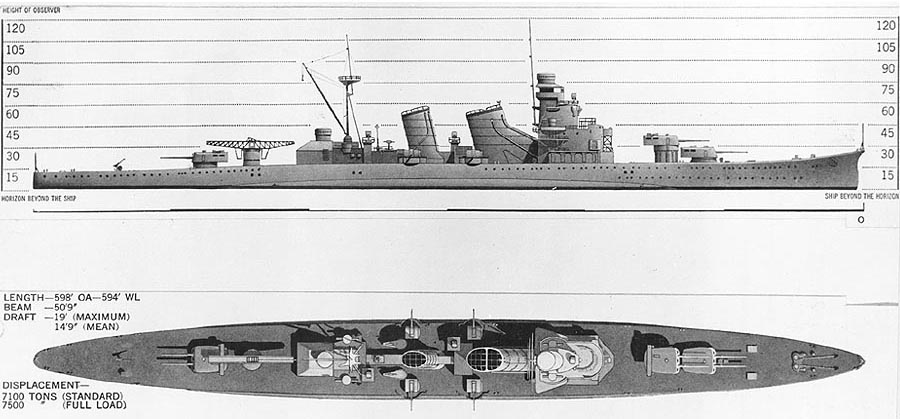Aoba-class Cruiser on:
[Wikipedia]
[Google]
[Amazon]
The were a 
class
Class or The Class may refer to:
Common uses not otherwise categorized
* Class (biology), a taxonomic rank
* Class (knowledge representation), a collection of individuals or objects
* Class (philosophy), an analytical concept used differentl ...
of two heavy cruiser
The heavy cruiser was a type of cruiser, a naval warship designed for long range and high speed, armed generally with naval guns of roughly 203 mm (8 inches) in caliber, whose design parameters were dictated by the Washington Naval T ...
s constructed for the Imperial Japanese Navy
The Imperial Japanese Navy (IJN; Kyūjitai: Shinjitai: ' 'Navy of the Greater Japanese Empire', or ''Nippon Kaigun'', 'Japanese Navy') was the navy of the Empire of Japan from 1868 to 1945, when it was dissolved following Japan's surrender ...
(IJN) which saw service during World War II
World War II or the Second World War, often abbreviated as WWII or WW2, was a world war that lasted from 1939 to 1945. It involved the vast majority of the world's countries—including all of the great powers—forming two opposin ...
.

Design
The of heavy cruisers (also called "A class" cruisers in the Imperial Japanese Navy) was originally planned to include and her sister ship . The two ships were laid down in early 1924 with that intent. In 1924 the IJN Naval General Staff pressured the acting head of the Basic Design Section, Kikuo Fujimoto, to use the newly designed twin "type C"gun turret
A gun turret (or simply turret) is a mounting platform from which weapons can be fired that affords protection, visibility and ability to turn and aim. A modern gun turret is generally a rotatable weapon mount that houses the crew or mechani ...
s on the ''Furutaka''-class ships. Fujimoto agreed to modify ''Aoba'' and ''Kinugasa'', but it was already too late to retrofit and , which had been laid down in late 1922. The two ships were subsequently renamed as a separate class, but ''Furutaka'' and ''Kako'' were eventually upgraded with twin turrets in 1937 when all four ships received 203mm main guns.
The modifications were significant. The six semi-turrets, 1 through 6, were replaced by three twin turrets, two fore and one aft. The main superstructure was also modified to accommodate the different fire control
Fire control is the practice of reducing the heat output of a fire, reducing the area over which the fire exists, or suppressing or extinguishing the fire by depriving it of fuel, oxygen, or heat (see fire triangle). Fire prevention and control i ...
requirements of the twin turrets. Other design modifications included using /45-cal HA guns rather than the guns. The airplane takeoff platform, part of which mounted atop the number 4 semi-turret, was replaced with a catapult fitted just fore of the No.3 twin turret. The superstructure aft of the funnels was extensively modified due to the new catapult. The catapults weren't ready before the ships were commissioned. ''Kinugasa'' had a compressed-air unit mounted in March 1928, while ''Aoba'' had a gunpowder-propelled model mounted in March 1929.
''Aoba'' and ''Kinugasa'' were otherwise built on the same hull as ''Furutaka'' and ''Kako'', with identical machinery and armor.
As built the ''Aoba'' was more than 900 tons heavier than its design weight, with negative effects on the performance of the ships similar to that of the ''Furutaka'' class overweight condition.
Modernization
In 1930, the Naval General Staff, concerned by the limitations on the size of their navy by the London Naval Treaty won approval for an extensive modernization program of the "A class" cruisers. To offset the numerical superiority the U.S. Navy enjoyed, the planned upgrades included the latest weapons, protection, fire control systems, and communication equipment. In the spring of 1930 the two ships had their manually-operated 12 cm anti-aircraft guns replaced with improved electro-hydraulically operated units. ''Kinugasa'' was refitted with a gunpowder-propelled catapult a year later. Extensive modernization of the ships began in late 1938, lasting until they were recommissioned two years later, as follows:Lacroix, ''Japanese Cruisers'', pp. 258-260 The main battery was replaced by /50-cal Mark II guns. Although turrets and gun mounts were unchanged, the powder and shell hoists were modified for the larger shells and to prevent flarebacks in the turrets from traveling to the magazines. Light anti-aircraft defenses were improved by 4 twin sets of 25 mm machine guns and 2 twin machine guns. The 6 pairs (3 per side) of fixedtorpedo tube
A torpedo tube is a cylindrical device for launching torpedoes.
There are two main types of torpedo tube: underwater tubes fitted to submarines and some surface ships, and deck-mounted units (also referred to as torpedo launchers) installed aboa ...
s mounted on the middle deck were replaced with 2 quadruple mounts using the powerful Type 93 torpedo
The was a -diameter torpedo of the Imperial Japanese Navy (IJN), launched from surface ships. It is commonly referred to as the Long Lance by most modern English-language naval historians, a nickname given to it after the war by Samuel Eliot Mori ...
, located on the upper deck, one on each side of the catapult.
The bridge structure was rebuilt almost identically to the ''Furutaka'' class modifications to accommodate the latest rangefinders and fire control equipment for the main battery, antiaircraft and torpedoes.
Of the twelve original boilers, two smaller ones were mixed-fuel capable. They were replaced with oil-fired units. Their coal bunkers were replaced with fuel-oil tanks.
The above modifications added 576 tons to the ships. To prevent the draft from increasing even more, and to improve stability, bulges were added, simultaneously enhancing anti-torpedo protection. As a result, the ships' beam was increased to .
Ships in class
References
Books
* *External links
* {{WWII Japanese ships Aoba Cruisers of the Imperial Japanese Navy Ships built in Japan